Table Of Contents

Onkar Sumant

Koyel Ghosh
Analyzing the Impact of Top 5 Emerging Markets on the BFSI Domain in Q2 2025

The increasing focus of developed and developing countries on financial inclusion has been one of the most important developments in the BFSI sector in the past few years. Financial inclusion refers to an approach to ensure that all sections of the population, especially the marginalized citizens, get access to affordable banking and other financial services. Almost all nations across the globe have launched initiatives that aim to bring the vulnerable population within formal banking channels. For this, the use of digital technologies and mobile applications has increased exponentially, thus opening new avenues for growth in the BFSI domain. Along with this, several emerging markets contributed to the expansion of the sector in the second quarter of 2025. The newsletter highlights the role of these industries in the growth of the landscape and presents a detailed analysis of the various factors impacting their rise.
Secured Lending Market
Secured lending is a type of financial borrowing mechanism wherein the borrower pledges his/her assets as collateral, which can be seized by the lender in case of default. Generally, collateral can take many forms, ranging from real estate properties and jewelry to personal high-end vehicles. One major reason behind the growing popularity of secured lending mechanisms is that the loans offered through this route have a lower interest rate than other financial arrangements. The secured lending market accounted for $12.4 trillion in 2023 and is expected to gather a revenue share of $34.3 trillion by 2033, citing a CAGR of 10.5% during 2024-2033.
The AMR report classifies the industry into various segments based on loan type, lender type, and end user. Based on loan type, the business segment held a significant market share in 2023 and is estimated to witness significant growth in the next few years. The growing demand for loans from businesses of all sizes for equipment purchase, working capital, and operational expansion is predicted to boost the revenue of the market in the coming period.
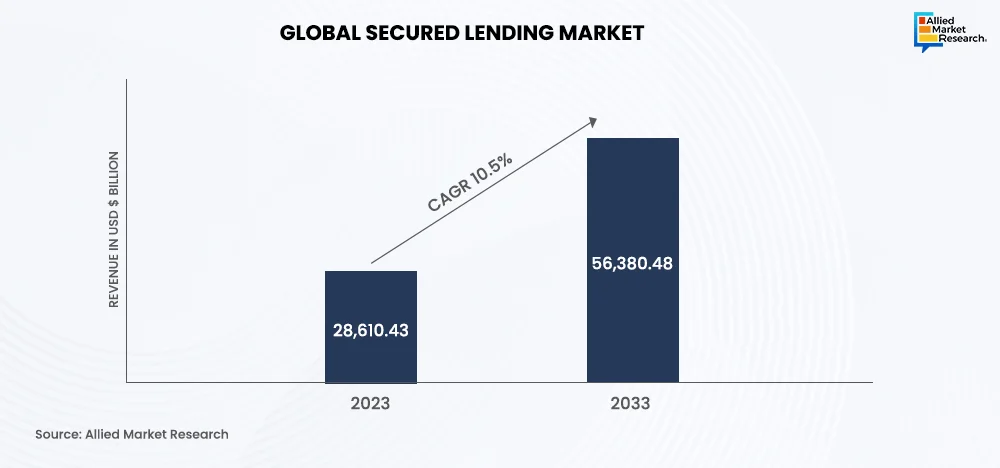
Universal Life Insurance Market
Universal life insurance is a type of insurance policy that offers a death benefit in addition to a cash savings component. The universal life insurance market was valued at $59.7 billion in 2023 and is anticipated to gather a revenue of $132.3 billion by 2033, rising at a CAGR of 8.1% during 2024-2033. The growing adoption of low-cost insurance plans is expected to be the primary growth driver of the industry in the near future. Furthermore, the rising use of digital technologies by insurance companies is anticipated to boost the revenue share of the market. In addition, the surge in demand for personalized insurance policies is predicted to create numerous growth opportunities in the sector.
As per the segmental analysis offered by the AMR report, the guaranteed universal life insurance segment is anticipated to have the highest growth rate in the coming period, owing to the growing awareness regarding the importance of financial planning. Moreover, technological advancements in digital connectivity have helped companies to develop solutions that cater to the needs of their consumers efficiently. These platforms and applications strengthened the position of the market in the second quarter of 2025.
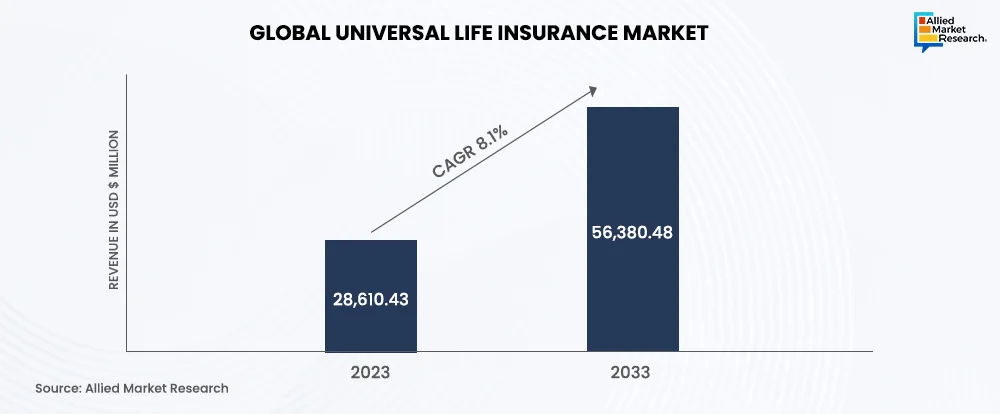
Islamic Finance Market
The Islamic finance market accounted for $2.5 trillion in 2023 and is anticipated to gather a revenue of $7.7 trillion by 2033, citing a CAGR of 12% during 2024-2033. In the last few years, Islamic financial institutions have been able to reach underserved sections of the population across the globe and offer an alternative to conventional interest-based lending. Additionally, the growing investments by Islamic financial institutions in renewable energy, education, and affordable housing are predicted to drive industry growth. Moreover, the surge in demand for sharia-compliant financial products is anticipated to boost the revenue share of the landscape.
The AMR report offers an in-depth analysis of the performance of the industry in various regions across the globe, including Asia-Pacific, North America, LAMEA, and Europe. The LAMEA region held the largest market share in the industry owing to the growing number of Islamic financial institutions in countries like Saudi Arabia, UAE, Qatar, etc. Additionally, the increasing governmental support for sharia-compliant fiscal products is anticipated to help the sector flourish.
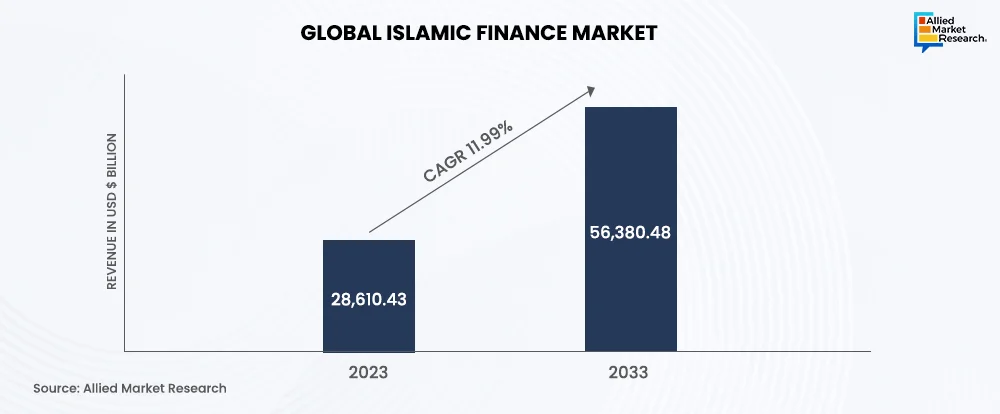
BFSI Crisis Management Market
The BFSI crisis management industry accounted for $15 billion in 2023 and is predicted to gather a revenue share of $72.3 billion by 2033, growing at a CAGR of 16.7% during 2024-2033. BFSI crisis management solutions are specified technologies that help users tackle unforeseen incidents, emergencies, and accidents. The advent of innovations such as Artificial Intelligence, machine learning, and big data is predicted to accelerate sectoral growth in the future. Moreover, the rising number of cyberattacks, data breaches, and malware threats is predicted to create favorable conditions for the growth of the industry.
The AMR report divides the market into various segments based on component, application, enterprise size, and end user. By component, the solution segment is anticipated to witness significant growth in the industry owing to the rise in the need for regulatory compliance, real-time monitoring, and incident response. The increasing emphasis of financial organizations on improving the overall customer experience is projected to augment the growth rate of the landscape in the years to come.
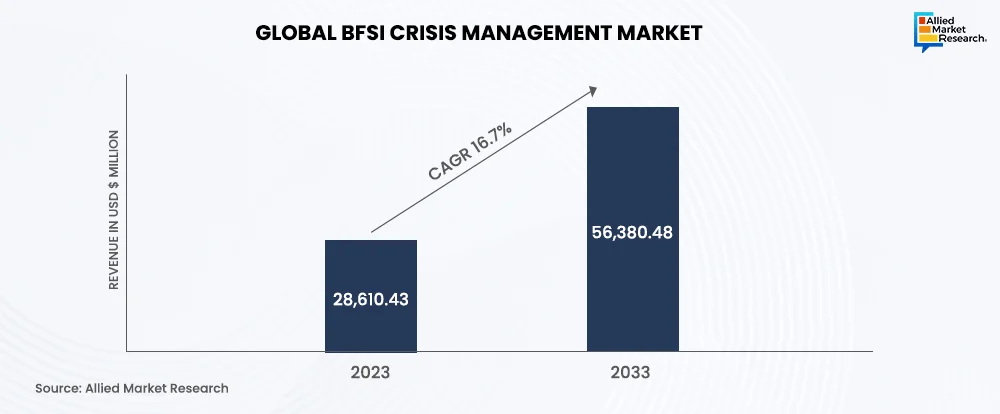
Cards Payment Market
The card payment industry was valued at $28.6 trillion in 2023 and is anticipated to register a revenue of $56.4 trillion by 2033, rising at a CAGR of 6.9% during 2024-2033. The growth in the e-commerce sector has been the primary reason behind the transition toward card payment solutions. This has led to a surge in online transactions, thus generating numerous lucrative opportunities for the growth of the card payments sector. Additionally, the rise in popularity of contactless payment technologies such as NFC and EVM chips is anticipated to help the market flourish.
The AMR report provides a comprehensive analysis of the major sociocultural, economic, demographic, legal, political, administrative, and scientific factors influencing the growth of the industry in various regions across the globe. The Asia-Pacific region is anticipated to dominate the industry in the near future due to the surge in the number of digital banking transactions. Additionally, the growing preference for mobile apps that aid in online payments is predicted to increase the footprint of the landscape.
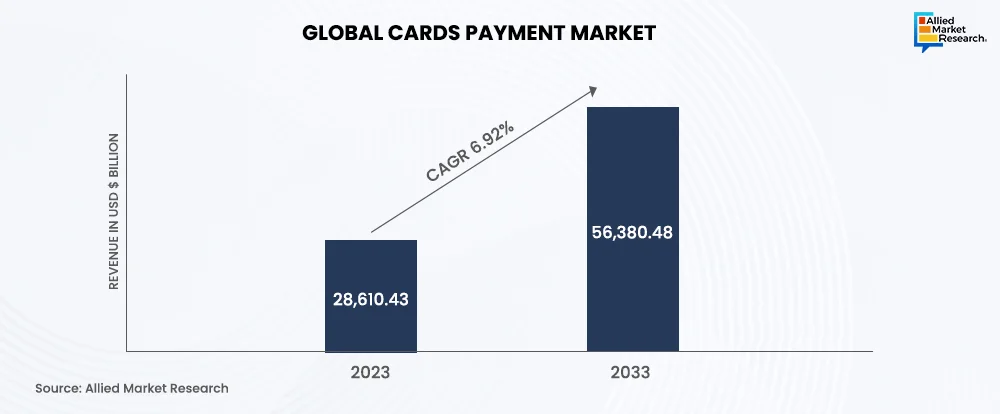
In essence
The growth of the BFSI domain is attributed to the rising demand for digital technologies and mobile applications that facilitate easy financial transactions and payments. The rise in focus on improving the accessibility and affordability of various banking services for vulnerable and marginalized sections of the industry boosted the revenue share of the BFSI domain in the second quarter of 2025. Moreover, the emergence of advanced technologies such as AI, data analytics, and machine learning is predicted to accelerate sectoral growth in the near future.
For more information on the latest growth drivers and investment opportunities in the BFSI industry, contact our experts, today!

